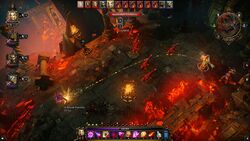RPG Codex Review: Dark Souls: Prepare to Die
RPG Codex Review: Dark Souls: Prepare to Die
Review - posted by Crooked Bee on Mon 1 October 2012, 19:24:28
Tags: Bandai Namco Entertainment; Dark Souls: Prepare to Die; From SoftwareDark Souls is an action RPG developed by Japanese company From Software (King's Field, Shadow Tower, Armored Core) and originally released last year for PS3 and Xbox360, with Namco Bandai as publisher. In August 2012, a PC port of the game with additional content, Dark Souls: Prepare to Die, saw the light of day. So how is the port? Average Manatee and praetor have set out to find out. In contrast to Average Manatee's general review of the game, praetor's review focuses mainly on the new content and the quality of the port. These are two distinct opinion pieces, so they may not fully agree with each other.
We'd like to thank the reviewers for writing this up, and Namco Bandai for a review copy of the game.
Part 1: Dark Souls: Prepare to Die Review
[Written by Average Manatee]
Dark Souls is the spiritual successor to Demon's Souls, an action-adventure RPG with an emphasis on exploring lonely, repressive environments. Developed by From Software, responsible for the King's Field series, the Souls series has enjoyed both widespread popularity and disdain for its supposed brutality and unforgivingness towards those who dare play it. Thanks to this popularity, Dark Souls is now seeing a release on the PC, a first for From Software, to a very rocky reception. How well does Dark Souls stack up, and is the PC version worth the wait?
Story
Dark Souls presents a bleak, dying world. The Age of Fire, ruled by the gods who ended the Age of Dragons and brought light to the world, is over. Most of the gods are gone, the rest trying to hold on to the last remnants of power that they have. The only source of protection and warmth for humanity is in the bonfire, a last bastion of the Age of Fire that can only be powered by the sacrifice of a human soul. As human souls dwindle, people become undead, a quasi-human state in which they can either collect other human souls to empower themselves or lose their own and become feral Hollowed creatures. The game starts with the player, a new undead, thrown into a prison for undead to sequester them from the rest of humanity.

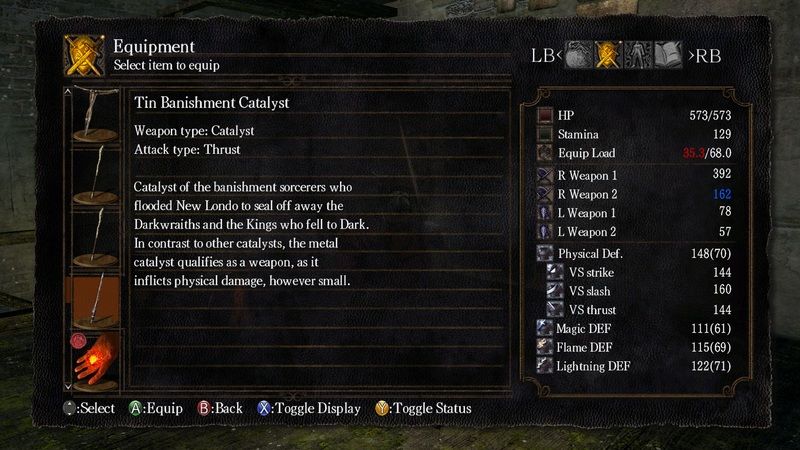
Some NPCs will hardly budge when asked for information, but many items have a tale to tell
Dark Souls intentionally leaves only bits and pieces for the player to piece together from the little that NPCs you meet may tell you and the information you find from various historical artifacts. This may have been a lost art of storytelling in games, but expect no plot dispenser NPCs who will sit with you while you make your way through a 10-layer deep dialog tree of interrogation. Don't expect your all-knowing journal to track and summarize every plot detail you have found to hand you a cohesive narrative on a platter. Certainly expect no villains to appear and detail their dastardly plan while twirling their mustache and insulting the impudence of daring to face them. Arguably there isn't even a real antagonist in the game beyond the world itself. Only a large cast of characters big and small, most of them struggling to maintain their grip on life and sanity. Some of them are failing, and some you will cause to fail.
Along with not feeding you the plot on a platter, Dark Souls is equally mysterious about the choices you have to make. Because in the end, Dark Souls is a game about actions, not dialog choices. It expects you to figure out what your choices are and make one for yourself. Where some games may permit inaction, in Dark Souls that's the quick route to getting multiple NPCs that provide essential services killed. It's also entirely possible that the majority of players won't even realize the existence of a decision between alternate endings, so subtle and natural a thing it is.

Sun bros chilling. Warning: staring at the sun too long may cause insanity
Or you can ignore everything entirely and coast through the game as a series of go here and kill stuff-quests. I've been assured from very reputable sources in the gaming industry that the quality of a plot is entirely irrelevant to a game based around swinging your sword to kill things.
Environment and Obstacles
As one might expect, Dark Souls offers a very dark and hostile world. The environment has a very European-inspired look, with castles, dungeons, cathedrals, and similar architecture dominating much of the landscape. Other areas include forests, cities underground/atop lava/flooded, and other environments. Areas are all unique and succinct; you'll never get a feeling of tediousness from opening a door to find the same room you've seen copy pasted five times before. Traps are spread throughout the game, and range from obstacles as blunt as giant boulders of doom rolling down your path to ones as simple as enemies that are smart enough to ambush you around corners. There is always reason to be alert and careful in the world of Dark Souls.
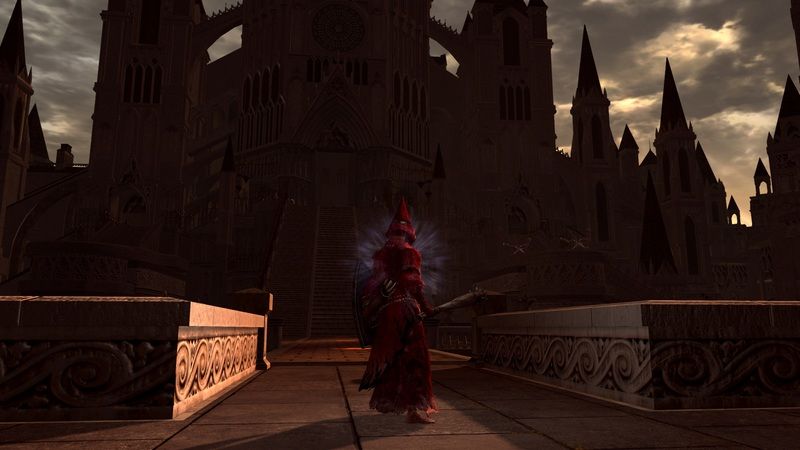
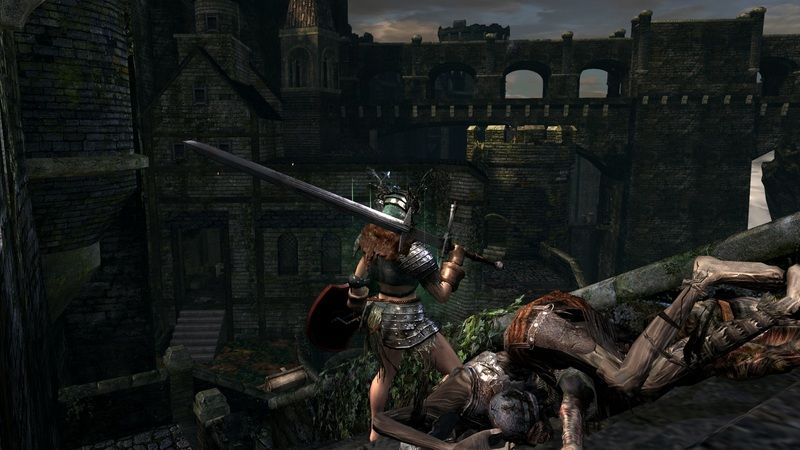
For me, the cathedrals and castles are standout pieces of the game.
In a departure from Demon's Souls, the entire world of Dark Souls is interconnected. Aside from a few areas that are cordoned off from the main area it is possible to traverse the length and breadth of the world without a loading screen in sight. There are often multiple access points to each environment, leading to "ah hah" moments of realization as a new shortcut back to a previous area is found. If one criticism can be leveled at the world at large, it is that there is often a number of abrupt changes from one area to the next. Still, the positives of the intertwined architecture certainly outweigh this negative.
Almost as varied as the environments of Dark Souls are the enemies that you will face. It's clear a lot of detail went into their designs. Every new one encountered will require learning its move-set and attack patterns, which often have a lot of variance such that even an enemy you have killed ten of will have a surprise or two still unrevealed. The variety also cannot be overstated. Where some games may be content to palette swap enemies for each new area and call it a day, most areas in Dark Souls will introduce an entirely new enemy to encounter. At times I almost wish that From Software had reused older enemies a bit more often. Some, like the thieves in the Lower Undead Burg, only appear at a handful of points in a single area.
Bosses have a similarly impressive array of encounters. A handful of them are poorly designed fights of hitting the glowing weakpoint (Bed of Chaos) or simply health-bloated whack-fests (Gaping Dragon), but the majority are of a very high caliber. Most will require a sound knowledge of the boss's moves and knowing when to attack, dodge, block, or just turn tail and run. Boss fights like Smough & Ornstein and Gwyn are absolutely unforgettable, with players being forced to rise to the challenge of an unrelenting assault by very aggressive human-like foes. Bosses in general tend to be more aggressive in Dark Souls than Demon's Souls, don't expect to be able to back off and heal quite as easily.
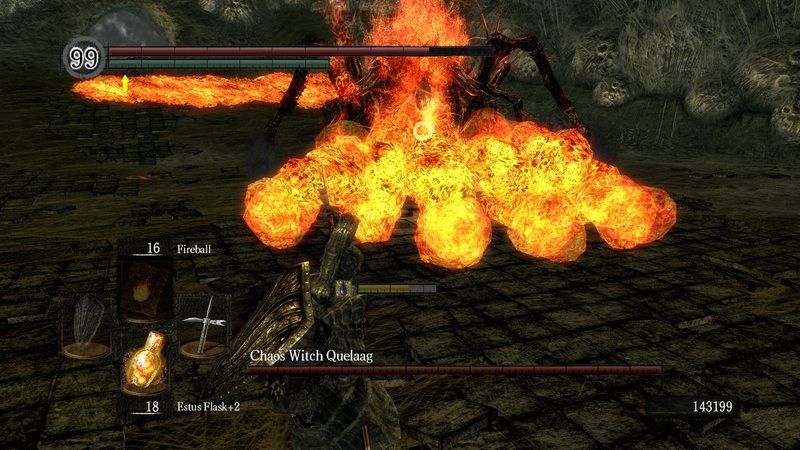
All bosses are impressively realized and completely distinct from one another.
Controls
Dark Souls is a fairly conventional aRPG. You will run around and try to poke sharp objects into enemies more effectively than they are poking sharp objects into you. Controls are fairly standard and obvious, with camera controls, movement, various forms of attack for each hand, and the utilization/selection of various items and equipment. There are a handful of special attacks the require combinations of inputs, but they are quite simple and easily mastered.
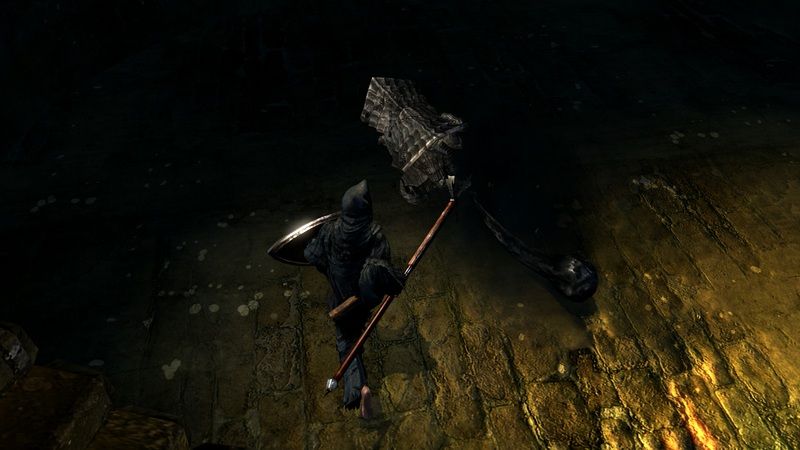
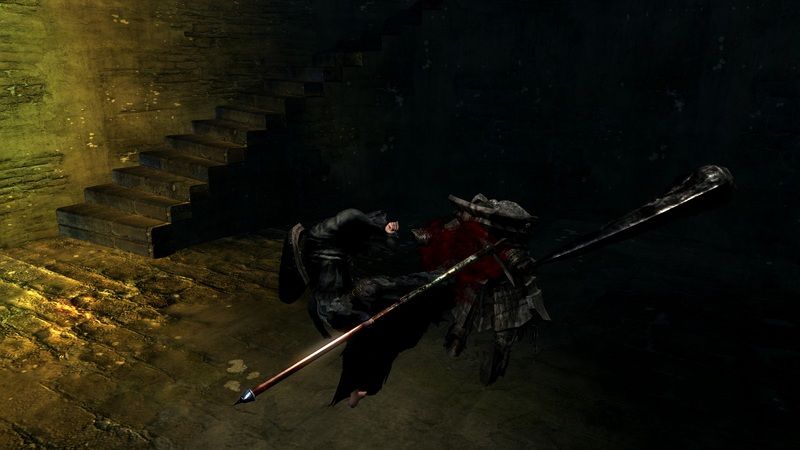
Sometimes you can be surprised by sub-boss fights from a giant hammer coming down behind you as you run through a doorway. Stay agile
Unfortunately there are a number of handicaps that are present due to the constraints of console controllers. Selecting and managing items and spells is a chore, especially when you need to go through 5 or 6 spells to find that one you need and only have a second to do it. The awesome button of Dark Souls is particularly monstrous, as it combines the function of dodging, rolling, jumping, and running depending on its use. Everyone is going to die a few times from rolling into a pit when a jump was intended or jumping straight up into a boss's hammer when you wanted to roll under it. Thankfully, these problems are fairly rare once you get used to things.
Character Creation and Advancement
Characters are fundamentally determined by their base attributes, comprised of Strength (for wielding heavy items), Dexterity (wielding lighter weapons), Vitality (health), Attunement (spell slots), Endurance (stamina, to be used for movement/blocking, and equip weight, to determine how fast you move under load; a very important stat), Intelligence (ability to master sorcery), Faith (ability to master Miracles), and Resistance (where points go when they want to be wasted). Spending souls (the currency of the game) to raise a stat by one increases your level by one, which modestly increases your base resistances and increases the average level of players you will be able to interact with online. Souls tend to be a very fluid resource; you'll gain them by the hundreds and then spend them all to raise a stat by 10 or 15. Then you'll lose a thousand souls in a stupid death, get frustrated with the area you were in and explore someone else to get thousands more before you know it. Diminishing returns on stats, escalating costs to level, and one-time finds of large amounts of souls tend to discourage level grinding, so if you reach a brick wall it's usually a much better idea to explore somewhere new rather than kill the same enemies for an hour to level up. Coming back with a new shield or sword is an excellent way to get payback for a few dozen deaths.
Aside from the base stats, there are the derived stats, such as defense against each element (physical/magic/fire/lightning), resistance to bleed (% health damage), poison (damage over time), and curse (new to Dark Souls, causing instant death and loss of 50% max health until it is cured), and poise (also new to Dark Souls, the ability to not be interrupted during your attack by attacks against you). All of these can be increased by some combination of armor, weapons, items, and stats.
In addition, there is also the humanity stat, which is gained and lost through gameplay. Humanity increases the chance to find items, increases your curse resistance, and mildly increases your other resistances similar to leveling. Pyromancy magic is almost another stat in itself, a form of magic that relies not on the character but on the strength of the flame that is carried. Pyromancy can only be upgraded through a copious investment of precious souls.

What a glorious list of stats
Each character class starts out with a different array of stats and items. A Mage, for example, will have only enough Strength to wield a dagger, but will have the attunement and intelligence to slot a great many magical spells. A fighter will start with a strong set of armor and shield along with the ability to wield most strength-based weapons of the game that aren't dropped by a 20 foot tall monster, but the weight of it may make him unwieldy without more Endurance. Due to the free-form stat system, no classes are permanently locked out of other advancement paths, but spending twenty levels as a Fighter just to become even magically with a level 5 Mage is a choice the player will have to make.
Equipment is unlike most RPGs in that armor or weapon does not become obsolete. Equipment is upgradable throughout the game so that a favorite weapon can remain viable for as long as you choose to use it. Indeed, some classes will start out with some of the most effective weapons and armor available. Available armaments range from the standard bows, swords, spears, etc., to unique weapons from bosses forged from their souls, improvised from their cut-off body parts, or simply taken from their corpses. Contrary to games like Diablo, weapons in Dark Souls are much more than a DPS attached to a weapon model. You'll want to take into account the range, speed, attack area, guard breaking ability, damage type, along with various quirks that each weapon category may have (spears can attack while still hiding behind a raise shield, daggers and rapiers have large bonuses to ripostes and backstabs, etc.). Each weapon definitely has strengths and weaknesse, e.g., trying to backstab a 50 foot dragon is rather futile, so there is no best overall choice. Or rather, the best weapon will be the one that you have the most experience with, knowing exactly how to defeat any enemy you may find.

Smiths will become your best friends very quickly. Interestingly they seem to be the characters who best maintain their sanity. Perhaps their untiring devotion to their craft sustains them?
Magic is highly varied and a useful tool for most any build. Aside from the multiple variations of magic missile, mages can become invisible (insanely useful in certain areas), imbue their weapons or shields with magic for a short time, or simply cast a spell to provide light instead of needing to carry a lantern (which would otherwise preclude the ability to use a shield). Clerics provide a more varied selection of attack spells, along with healing and defense buffs. Casters also have access to Magic/Enchanted and Divine/Occult weapons which receive bonuses depending on the respective caster's magical ability, ensuring that even when out of spells they can both be formidable opponents.
New to the Souls series is the option of joining a Covenant. This allows you to further define your character and attach yourself to an NPC or group of NPCs. Serving them can be as simple as donating precious items to them, or as complex as requiring you to invade and dispense justice on those who have committed in-game sins. Only one covenant can be joined at a time though, so choose wisely. Rewards can range from powerful items and spells to increasing the chance of receiving online help from other players.
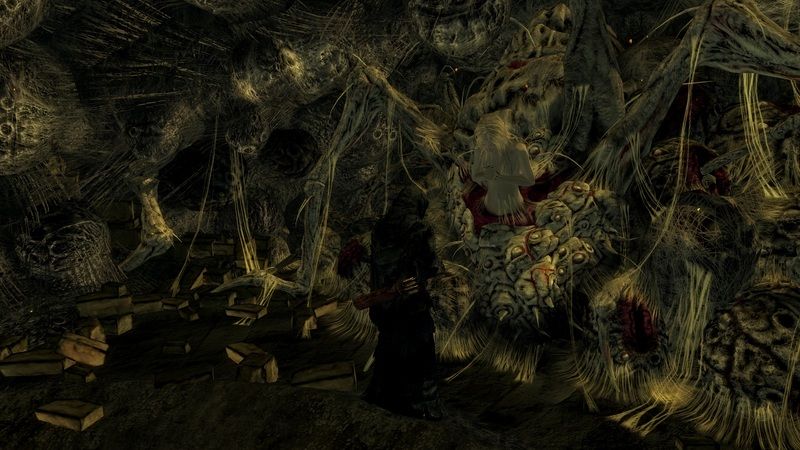
She just needs your humanity to survive. How can you deny a half-spider witch of Chaos such a small thing?
The standout feature of the character system is just how many options are viable. Aside from resistance, every stat has a viable place in a character build, and most combinations will have a weapon or spell available to support them. Whether it's a weapon that draws upon multiple stats or a new utility spell to be unlocked, most players will find incentives to explore different sets of builds. Furthermore, since any stat allocation will unlock dozens of different weapon types, there is always ample opportunity to switch to a different weapon and move-set even within a build.
Combat
Combat in Dark souls is swift and brutal. With most enemies able to defeat players in a matter of a few blows, good blocking and evasion becomes essential. Evasion drains stamina, blocking drains both stamina and (potentially) health, and since attacking drains stamina as well players must strike a good balance between attack and defense. At the same time, combat is also slow and deliberate. After learning which enemy moves to block, which to dodge, and which to interrupt with your own attacks it becomes almost child's play to defeat even the strongest of enemies. Probably the greatest feeling of accomplishment is to enter a fight that used to be troubling and effortless dispatch each enemy without taking a scratch.
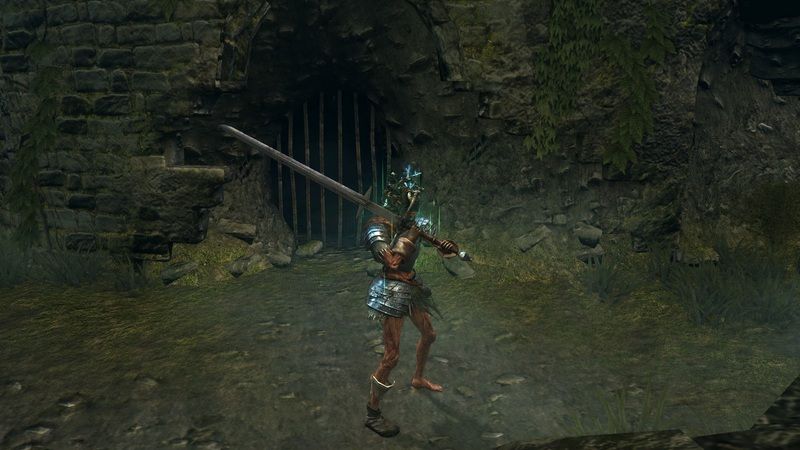
"When life gets you down and nothing is going your way, put your faith in a big sword"
Estus Flasks (health potions) and spells are all limited use abilities that can only be restored by resting at a lit bonfire, which also restores most common enemies to their normal locations. Exploring new areas is therefore a test of how far you can go before running out of steam and being forced to retreat again. Kindling bonfires while human can increase the number of Estus Flasks that can be carried, but only at the cost of humanity.
Death is not an obstacle in Dark Souls. Dying drops all souls carried by the player along with their humanity at the point of their death, curses them as a Hollow, and returns them to the last encountered bonfire. Touching the bloodstain of a previous life will restore the souls and humanity, leaving only the curse of hollowness as a penalty. The true danger is a second death, which will remove the first bloodstain in favor of the newest. If Dark Souls is a game centered around careful play, regaining a bloodstain is the point at which the most care must be exercised.
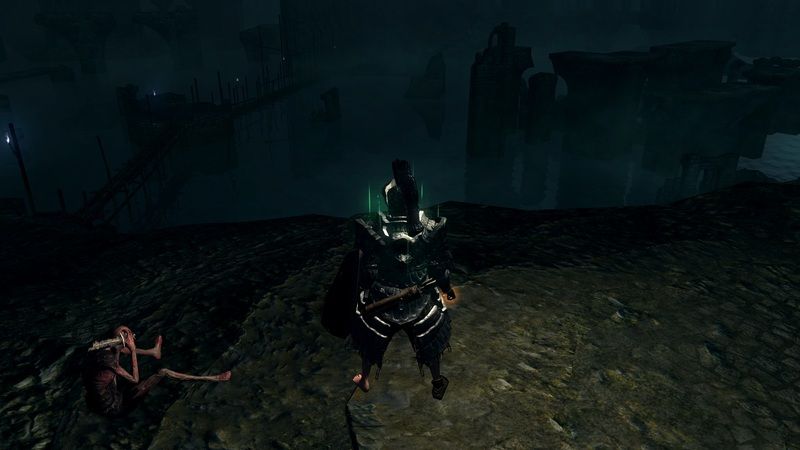
Some developers might question letting players adventure into one of the penultimate areas of the game from an early level. Dark Souls asks: How soon can we put in an express elevator? The answer is as soon as the tutorial is over.
Multiplayer shares the unusual system pioneered in Demon's Souls. To be Hollow will confine you to singleplayer in your own world, with the exception of scattered messages left by other players and the bloodstains they leave to let you witness their final moments of life. As a Hollow the only opportunity to encounter other players is to be summoned by them as a Blue Phantom to help, which gives souls and a point of humanity as a reward. On the flip side, being human allows you to both summon and be summoned, along with risking being invaded by Red Phantoms looking to kill you for your humanity. And naturally, you can invade other players yourself. This presents a natural risk/reward mechanic between the tradeoffs of Human and Hollow, with Human possessing the greatest rewards but also the higher risk and cost of death. Unfortunately, multiplayer is somewhat mired by the fact that Dark Souls enforces a somewhat harsh level restriction for players to join up. Thanks to Dark Soul's open-ended world, it's easy to be outside the 'normal' level range of an area and have scant few opportunities for cooperation. Connecting to other players can also be finicky, expect summonings to fail as a semi-regular occurrence.
One new mechanic that Dark Souls brings to the table is the introduction of summon-able and invading NPC phantoms. Depending on your actions within the game some NPC phantoms may be summon-able before certain boss fights and others may invade at certain points in a level. The same rules apply, only Humans can summon and be invaded by NPCs. This mechanic shows real promise, unfortunately it is poorly executed. NPC Blue Phantoms often make boss fights far too easy, and NPC invaders only invade at static points and are generally pretty easy to dispatch. Some further development of this feature would be very welcome, with Blue NPCs better balanced for boss fights and Red Phantoms both more vicious and appearing randomly as you adventure through an area.
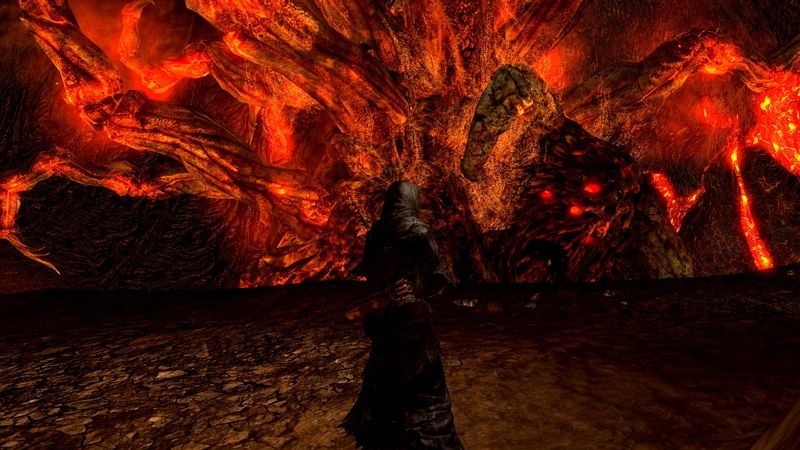
He may be the biggest boss in the game, but if you look closely he is actually crying. I hope everyone who plays Dark Souls finds out why and feels just as bad about killing him as they did Astraea in Demon's Souls
Summary
Dark Souls is a very well-made aRPG that is sure to be enjoyable for anyone who is a fan of the genre. It has a number of minor flaws, yet does so many more things to the highest degree of excellence. Absolutely anyone who is interested or think they might be interested in a game of this style should play it. Dark Souls is an improvement on Demon's Souls and I hope that From Software will continue to improve themselves in sequels to come. I also hope that other developers of aRPGs (which seems to be most RPG developers these days) can learn from Dark Souls to make an aRPG done right.
Prepare to Die (PC) Version Addendum
Thanks to a large and vocal demand for a PC port, From Software has released Dark Souls: Prepare to Die edition for the PC. Unfortunately from what I can gather From Software's development team has no experience at all developing or even playing PC games, so the PC version leaves a lot to be desired. I'll run down a quick pro/con list.
Cons:
Do the pros outweigh the negatives? Absolutely. Aside from the GFWL requirement, the cons are either still present on the console versions or input issues that won't be present if a controller is used. If you have hangups about not having a perfect FPS-like mouse input then feel free to stay away, but if you are comfortable with somewhat finicky mouse controls, a keyboard alone, or own a controller then the PC version is arguably the definitive version of Dark Souls.
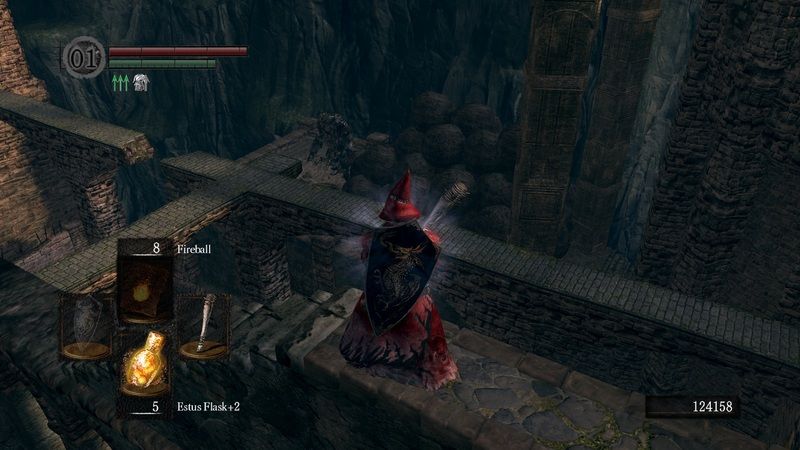
Part 2: Dark Souls: Prepare to Die: Port and New Content Review
[Written by praetor]
It was only a year ago that From Software released their sleeper hit action RPG Dark Souls to much (unexpected) critical and (expected) player acclaim. Not many would have predicted the game's sucess, its main selling point being its apparent difficulty, but after Demon's Souls' quick rise to popularity by word of mouth it was only logical that its spiritual successor would be even better received, on both a media and a financial level. Even fewer, however, would have predicted that an online petition could convince Namco Bandai to release a port of the game to the glorious PC. The petition ended up with almost 100,000 signatures, and it did not take long for the port to be announced. Whether it was a clever marketing ploy or a demonstration of the power of the internet masses, I'll let you be the judge. What was easy to predict, though, was the likelihood that the port, left in the hands of From Software with their little to no experience with the PC, would be sub-par and disappointing. Naturally, many were hopeful, but the initial reports from E3 and subsequent developer interviews made even the most optimistic approach Dark Souls: Prepare to Die with a dose of caution.
The Basics
At its core Dark Souls is a 3rd person action RPG with a big, relatively open world ripe for exploration, much akin to the Gothic series albeit with more linear, restricted areas and significantly more sophisticated combat mechanics that bring fond memories of a PC-exclusive title that was well ahead of its time when released more than a decade ago, Severance: Blade of Darkness. Much of Dark Souls' success, however, stems from its difficulty. Yes, you got it right, a AAA game that became popular because it was hard. And while the actual difficulty is as overstated and overrated as it is eagerly advertised, it is not surprising that it ended up being the main selling point in an era of gaming when major mainstream games pretty much play themselves. Therefore it should not come as a surprise that at least the more old-school inclined among us appreciated Dark Souls' penchant for punishing the players for their mistakes like the best games of old.
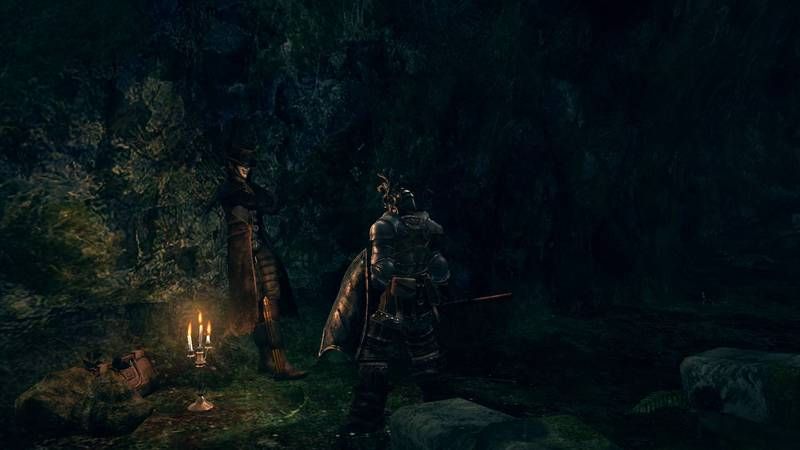
As this joker points out, it appears you're not the only one snatched from a future time. Perhaps Manus is in fact Doc Brown?
Compared to its genre brethren, on both the PC and consoles, the game is relatively difficult but more often than not fair, and if you are observant and aware of the mechanics, the surroundings, and the enemies you face, you will rarely die, thereby sparing yourself much backtracking and potentially a massive amount of frustration. The world as a whole and the specific areas in it are crafted with a great eye for detail, as far as both level design (full of secrets and shortcuts) and more superficial (but equally delightful) aesthetic pleasantries are concerned. The game is rather minimalistic in everything, from the near non-existent tutorial and next to no instructions to the way it presents the story and the lore, which offer more than meets the eye if you care enough to dig for it.
The Technicalities
It is a pity, then, that many of these excellently designed environments are marred by low-res, blurry textures and, if you did not bother to apply the resolution fix, a blurry mess at whatever resolution or AA setting you choose to play the game. Speaking of resolutions, it is unforgivable that a fan modder accomplished more for the visual aspect of the game in three weeks than From Software could (or would?) in the many months it took them to port it. Now we can only hope that enterprising modders will take it upon themselves to beef up the horribly mismatched low res textures (and who knows, maybe even the lower poly models) that stick out like a sore thumb next to the amazing high res ones.
Still, it must be admitted that these relatively minor aesthetic details hardly detract from the overall experience. What does is the choppy framerate. I do not have a high end computer, but my machine is more than perfectly capable of running almost all the most demanding games of today at full HD and maxed out details with a smooth framerate - with the exception of Dark Souls. Now, you might remember the E3 reports that claimed the game was borderline unplayable on Alienware gaming rigs due to its poor performance. I'm happy to report that either those claims were completely misleading or From Software actually managed to optimize the game a bit before release. Another thing of note is that while the performance can often be choppy and inconsistent, it is still miles ahead of the horrid clutter it was on consoles. On the PS3 and Xbox360, the infamous Blighttown would degenerate into a barely crawling slideshow whereas on the PC it manages to stay fairly consistent, framerate-wise, with the rest of the game. I can only imagine how smooth the port could have been in the hands of a more experienced PC developer.
But porting is not just pretty graphics and performance. It is also controls, and that is where we find From Software's porting at its worst. Even if you disregard that someone thought it would be a good idea not to introduce key rebinding, close your eyes to the wonky default control scheme, and don't care that an Xbox360 controller is the only device that the game tends to detect somewhat consistently - even if you can get over all that - there will remain the matter of the UI, lazily copy-pasted from the Xbox version so that no matter what type of controller you choose and what key you assign to the "use item" command, you will always see the annoying red "B" wherever you go. Taken together, all that is simply inexcusable. Then there is also the infamous GFWL and its save game corruption "feature," but personally I have not encountered any problems with it so far.
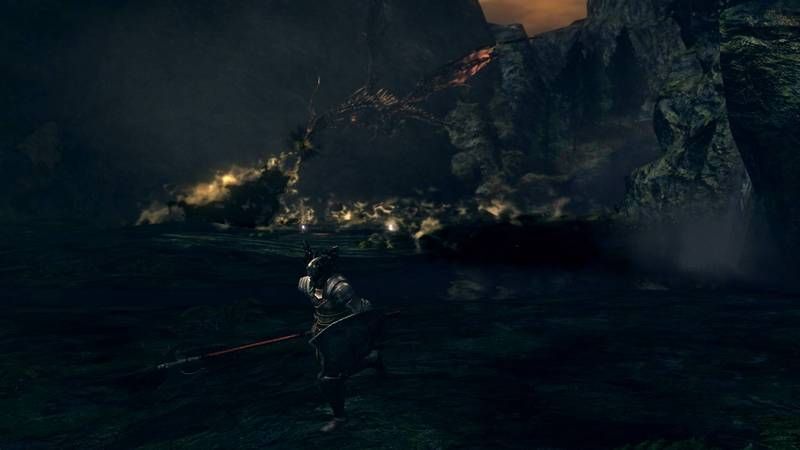
You will need some serious help to get this motherfucker down. If I ever wanted to be a dragon, Kalameet would be it.
Fortunately, the man behind the awesome resolution fix, Durante, has already implemented a texture replacement function, and even though the fixes still require a bit of work, the important thing is that they are available. Worthy of mention is also the mousefix that patches up the game's problems with mouse acceleration. Overall, it is pretty sad that you need mods to play Dark Souls properly and to its fullest potential, but on the other hand, it still requires much less tweaking and modding than your average Bethesda or Bioware game.
The One and the Many
Speaking of fixes, one thing that definitely called for a lot of patching if not a complete overhaul is the netcode. Unfortunately, the PC version suffers from the same problems that the console versions did. Due to the randomness of the multiplayer system, Dark Souls almost requires a NASA-worthy internet connection speed. The lag is omnipresent and so dreadful that you are regularly backstabbed from the front, parrying becomes a thing of chance, and you can see other players perform dance moves that would make Michael Jackson turn in his grave. Not even in my early days of playing Quake 1 and 2 in multiplayer over a 56k modem when all of us had pings well into the hundreds did I experience anything so bad.
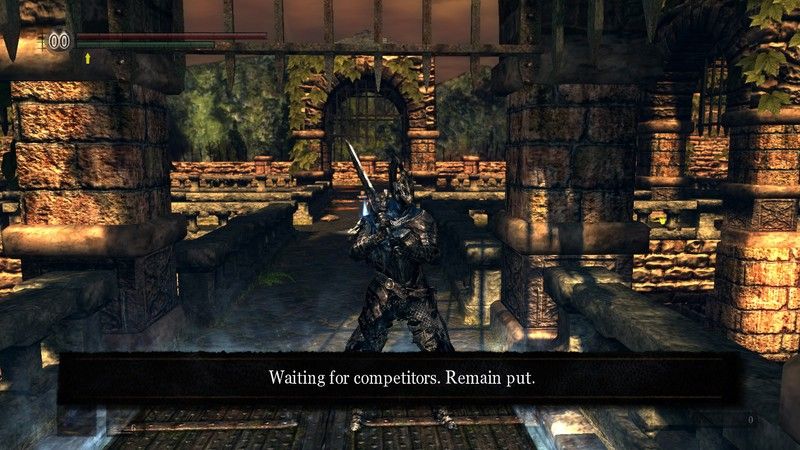
If you want to compete in the Arena, you will find yourself waiting more than fighting, so be prepared to look at the above prompt. A lot.
Admittedly, the uniqueness of Dark Souls' multiplayer system partially makes up for the problems. For one, there is no separate "multiplayer mode," multiplayer being seamlessly integrated in singleplayer. You can, of course, play in offline mode but then you are going to miss out on one of the game's best aspects: invasions. At every moment, your game world is connected to 31 others through a lobby system, so that other players may either attempt to help you out by placing signs that allow you to summon them to your world or challenge you by forcibly invading your instance of the world and trying to kill you. Both approaches offer their own challenges and rewards, some uniquely tied to specific Covenants and their ranks (something like guilds but with a heavy multiplayer leaning). The minimalism of the game's design also shows in multiplayer, where in-game communication is only possible through a couple dozen gestures that your character can perform or five newly introduced "carvings" that reproduce generic messages when used (such as "I'm sorry" or "Very good"), which greatly enhances the already lonely, isolated atmosphere. However, that also introduces unnecessary hassles to good old duels or co-op sessions, further complicated by the randomness of the lobby system and the bad netcode. The new content that ships with the PC and will come in the form of DLC on consoles next month also introduces an arena specifically for multiplayer, but more on that below.
Another thing that should be considered is the rampant cheating present on the PC and the pretty much non-existent cheating prevention measures on the part of From Software and Bandai-Namco. While no one cares if you cheat in singleplayer and even if the occasional invasion happens to end up in a hacker's world, cheating can really spoil the arena experience and prove to be an excessive hindrance to newbies in a game already full of gankers, griefers and twinks. The community has been rather vocal about this, especially as far as the presence of hackers in the arena is concerned, and apparently someone at Bandai-Namco has already taken notice. Hopefully that means some kind of anti-cheating mechanism will be introduced because, predictably, GFWL is proving to be woefully inadequate on its own.
The size of the community presents another potential problem of the PC version for multiplayer aficionados. Currently it is only a fraction of the significantly larger PS3 community, and summonings and invasions are nowhere as frequent. On the PS3, being of the right level in the right area will rarely get you to wait more than five minutes even in off-peak hours, while on the PC you can sometimes leave the game running for a whole hour without being summoned to such popular co-op boss fights as Ren and Stimpy. The situation is significantly better on weekends, though; is it because PC gamers actually have jobs while console players are mostly jobless kids? You decide.
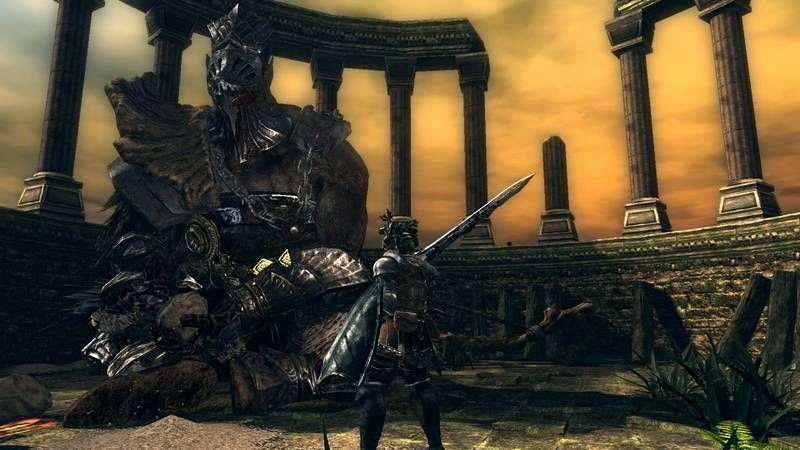
Pretty much all the new NPCs offer some substantial lore insights. They are also for the most part really badass.
Knights and Dragons
Content-wise the PC version is almost identical to the console ones, except for the 3 new DLC areas. The only changes are an altered boss cutscene if you undertake a specific task in a DLC area before fighting that boss, the addition of an enemy that drops the item required to access the DLC areas, new Lordvessel warp points, and some balance changes to existing equipment. Balance tweaks are something of a mixed bag, and although most are quite positive, the game still needs further tweaking; the current tweaks are mostly significant for PvPers and change very little for regular players.
The actually new content is not all that different from the main game, too. While aesthetically From Software bring to the table the same breathtaking design they are known for, most of the new equipment is functionally rather mediocre or even redundant and will mostly see use in normal PvE play and role-play builds. The Guardian Armor is almost a carbon copy of the Stone Armor (only the helmet is somewhat different but the rest of the set is 95% identical), the rest of the new armor sets are downright bad, and the Obsidian Greatsword is the only new weapon actually worth having - well, maybe the Silver Tracer too if you enjoy backstabbing/riposting. The other new weapons have some cool-looking R2 moves (that are rather impractical) but, just like the new armor, they are outclassed by stuff you find (and upgrade) much earlier in the game. The new spells, on the other hand, are powerful to the point of being overpowered in PvE - as if the old spells were not "easy mode" already - and finally provide some useful and useable offensive options to mages in PvP.
The DLC gives you access to 3 new levels "proper" plus a couple additional side areas. Disappointingly, one of them is a reworking of an old area - Royal Wood being essentially Darkroot Garden (and a part of Darkroot Basic) set in the past with new enemies, loot and bosses and some relatively minor structural changes - and another, The Chasm of Death, is rather small and dark, creating the impression of a mere "antechamber" to the final new boss.
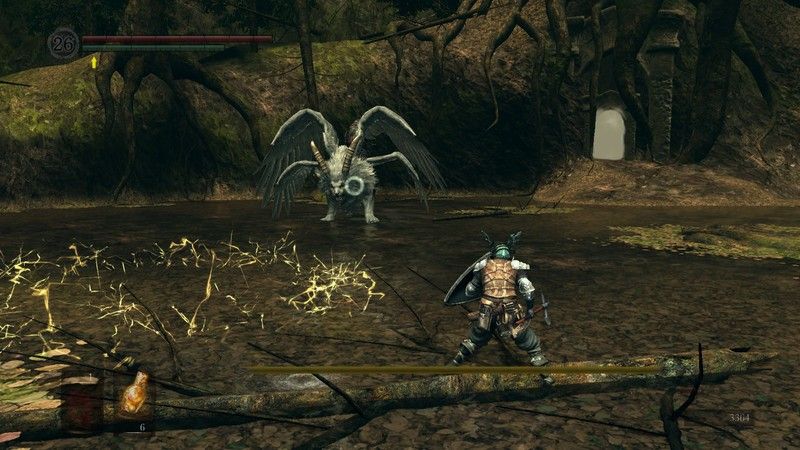
The new content puts you in the thick of the action from the very beginning
The largest and by far the most interesting new area is the Oolacile Township with its slightly slanted architecture further emphasizing Dark Souls' dark, oppressive atmosphere. In a way, it reminds me of a darker, more evil Painted World of Ariamis. It is a bit of a pity that it is so short and rather straightforward structurally, and does not offer much in the way of side exploration. In that regard, it is similar to Anor Londo or New Londo Ruins, in that it looks very large but only parts of it are accessible and as a whole it is quite simple to navigate. The Battle of Stoicism also deserves a special mention. It consists of two in-game multiplayer arenas, Ruins and Dais, designed for players to engage in PvP sessions (free-for-all deathmatch, 2 vs 2 team games and 1vs1 duels) without interruptions from random invasions... At least in theory. Unfortunately, the randomness of the multiplayer system also affects the arena, and playing with/against specific people is even more of a hassle than doing it the old fashioned way via summoning signs. Not to mention that the entire arena concept seems somewhat out of place in the game.
The new enemies, much like the new equipment, do not introduce anything substantially novel. The new Stone Guardians are not particularly different from the old ones, the Bloated Heads are only moderately dangerous for a new player (even if their sorcerous version pack quite a punch and the new magic is significantly harder to dodge than your regular soul arrows), the Scarecrows are pushovers and the only purpose of Humanity Sprites seems to be humanity farming. That said, From Software knows how to place and combine these enemies into fun and challenging encounters (and include amusing details like the scissor-armed Scarecrows tending to the trees in the Royal Wood).
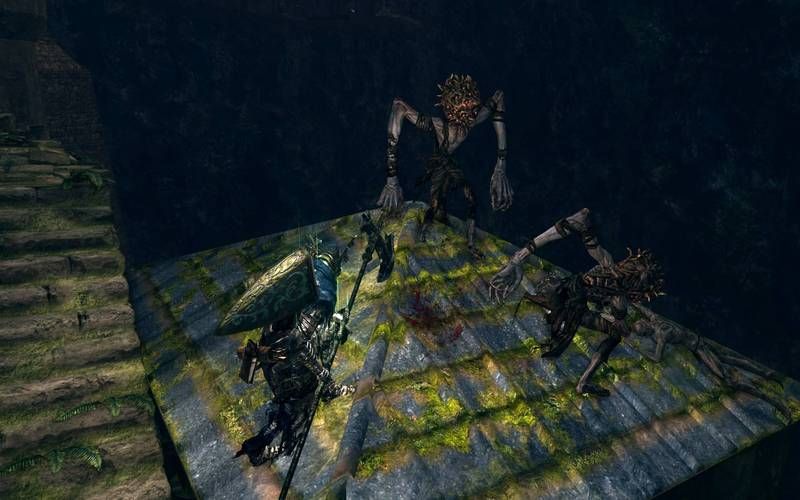
Most of the new enemies aren't terribly exciting by themselves, but the encounters are expertly designed so you'll rarely face only at a time
Speaking of encounters, most of the new bosses are some of the most memorable in the entire game, standing next to the very best in the original such as Gwyn and The Dynamic Duo. Even the first DLC boss, the Sanctuary Guardian manticore seen in the first screenshots of Dark Souls: Prepare to Die that showed up many months ago, can provide a challenge to new players with its relentlessness - and on top of that, revisiting that area yields a nice surprise. Actually, it seems that From Software turned aggressiveness (with a dose of unpredictability that old boss encounters severely lacked) into a major feature of the new bosses, making them much more intense and interesting. From the set-up to the actual fight, the optional boss should be a lesson to Bethesda and Bioware on designing dragon encounters in an ARPG. Hopefully From Software continue on this route for their next game.
All the new stuff comes "bundled" with a plethora of new information about the world and characters, so if lore is your thing, you will love the DLC. Some of the new NPCs also belong to the game's best. Gough's badassery is bound to impress, and Chester is the coolest son of a bitch in all of Lordran. It may be interesting to note that they are also probably the toughest NPCs in the game if you attack them (although admittedly that is not saying much considering that in the original NPCs were total pushovers).
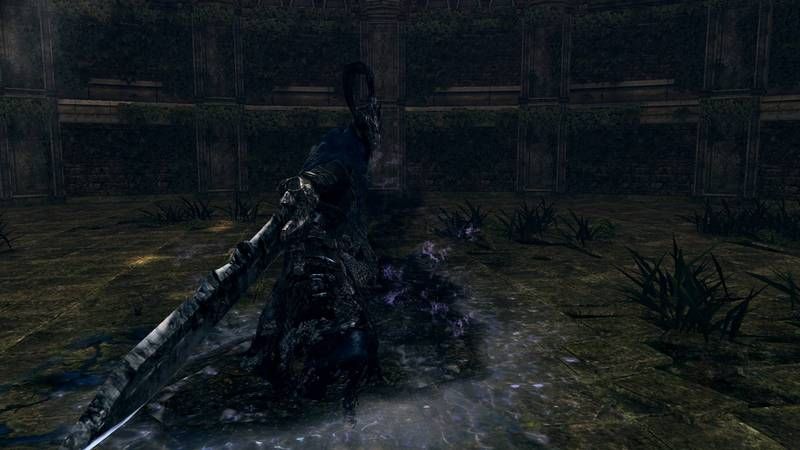
If you block a lot, the new bosses can quickly drain your stamina, punishing you if you aren't careful.
Conclusion
All things considered, I cannot say I'm disappointed with the product. Sure, "out of the box" the quality of the port is atrocious, but unlike most of its competitors Dark Souls: Prepare to Die only requires two small fan mods to bring out its full potential. The new content is also really good and on par with (or sometimes even better than) the main game, even if it rarely brings anything substantially new to the table.
So, should you buy the PC version or get the console version and wait for the DLC? The PC is definitely the superior singleplayer option (as befits the Master Race) with its superior performance, eye candy and mod potential and thus provides the ultimate Dark Souls experience. But if you already own a console version of the game and/or you are mostly into PvP, you are better off waiting for the DLC to arrive on consoles or at least for a Steam sale. Praise the Sun!
We'd like to thank the reviewers for writing this up, and Namco Bandai for a review copy of the game.
Part 1: Dark Souls: Prepare to Die Review
[Written by Average Manatee]
Dark Souls is the spiritual successor to Demon's Souls, an action-adventure RPG with an emphasis on exploring lonely, repressive environments. Developed by From Software, responsible for the King's Field series, the Souls series has enjoyed both widespread popularity and disdain for its supposed brutality and unforgivingness towards those who dare play it. Thanks to this popularity, Dark Souls is now seeing a release on the PC, a first for From Software, to a very rocky reception. How well does Dark Souls stack up, and is the PC version worth the wait?
Story
Dark Souls presents a bleak, dying world. The Age of Fire, ruled by the gods who ended the Age of Dragons and brought light to the world, is over. Most of the gods are gone, the rest trying to hold on to the last remnants of power that they have. The only source of protection and warmth for humanity is in the bonfire, a last bastion of the Age of Fire that can only be powered by the sacrifice of a human soul. As human souls dwindle, people become undead, a quasi-human state in which they can either collect other human souls to empower themselves or lose their own and become feral Hollowed creatures. The game starts with the player, a new undead, thrown into a prison for undead to sequester them from the rest of humanity.


Some NPCs will hardly budge when asked for information, but many items have a tale to tell
Dark Souls intentionally leaves only bits and pieces for the player to piece together from the little that NPCs you meet may tell you and the information you find from various historical artifacts. This may have been a lost art of storytelling in games, but expect no plot dispenser NPCs who will sit with you while you make your way through a 10-layer deep dialog tree of interrogation. Don't expect your all-knowing journal to track and summarize every plot detail you have found to hand you a cohesive narrative on a platter. Certainly expect no villains to appear and detail their dastardly plan while twirling their mustache and insulting the impudence of daring to face them. Arguably there isn't even a real antagonist in the game beyond the world itself. Only a large cast of characters big and small, most of them struggling to maintain their grip on life and sanity. Some of them are failing, and some you will cause to fail.
Along with not feeding you the plot on a platter, Dark Souls is equally mysterious about the choices you have to make. Because in the end, Dark Souls is a game about actions, not dialog choices. It expects you to figure out what your choices are and make one for yourself. Where some games may permit inaction, in Dark Souls that's the quick route to getting multiple NPCs that provide essential services killed. It's also entirely possible that the majority of players won't even realize the existence of a decision between alternate endings, so subtle and natural a thing it is.

Sun bros chilling. Warning: staring at the sun too long may cause insanity
Or you can ignore everything entirely and coast through the game as a series of go here and kill stuff-quests. I've been assured from very reputable sources in the gaming industry that the quality of a plot is entirely irrelevant to a game based around swinging your sword to kill things.
Environment and Obstacles
As one might expect, Dark Souls offers a very dark and hostile world. The environment has a very European-inspired look, with castles, dungeons, cathedrals, and similar architecture dominating much of the landscape. Other areas include forests, cities underground/atop lava/flooded, and other environments. Areas are all unique and succinct; you'll never get a feeling of tediousness from opening a door to find the same room you've seen copy pasted five times before. Traps are spread throughout the game, and range from obstacles as blunt as giant boulders of doom rolling down your path to ones as simple as enemies that are smart enough to ambush you around corners. There is always reason to be alert and careful in the world of Dark Souls.


For me, the cathedrals and castles are standout pieces of the game.
In a departure from Demon's Souls, the entire world of Dark Souls is interconnected. Aside from a few areas that are cordoned off from the main area it is possible to traverse the length and breadth of the world without a loading screen in sight. There are often multiple access points to each environment, leading to "ah hah" moments of realization as a new shortcut back to a previous area is found. If one criticism can be leveled at the world at large, it is that there is often a number of abrupt changes from one area to the next. Still, the positives of the intertwined architecture certainly outweigh this negative.
Almost as varied as the environments of Dark Souls are the enemies that you will face. It's clear a lot of detail went into their designs. Every new one encountered will require learning its move-set and attack patterns, which often have a lot of variance such that even an enemy you have killed ten of will have a surprise or two still unrevealed. The variety also cannot be overstated. Where some games may be content to palette swap enemies for each new area and call it a day, most areas in Dark Souls will introduce an entirely new enemy to encounter. At times I almost wish that From Software had reused older enemies a bit more often. Some, like the thieves in the Lower Undead Burg, only appear at a handful of points in a single area.
Bosses have a similarly impressive array of encounters. A handful of them are poorly designed fights of hitting the glowing weakpoint (Bed of Chaos) or simply health-bloated whack-fests (Gaping Dragon), but the majority are of a very high caliber. Most will require a sound knowledge of the boss's moves and knowing when to attack, dodge, block, or just turn tail and run. Boss fights like Smough & Ornstein and Gwyn are absolutely unforgettable, with players being forced to rise to the challenge of an unrelenting assault by very aggressive human-like foes. Bosses in general tend to be more aggressive in Dark Souls than Demon's Souls, don't expect to be able to back off and heal quite as easily.

All bosses are impressively realized and completely distinct from one another.
Controls
Dark Souls is a fairly conventional aRPG. You will run around and try to poke sharp objects into enemies more effectively than they are poking sharp objects into you. Controls are fairly standard and obvious, with camera controls, movement, various forms of attack for each hand, and the utilization/selection of various items and equipment. There are a handful of special attacks the require combinations of inputs, but they are quite simple and easily mastered.


Sometimes you can be surprised by sub-boss fights from a giant hammer coming down behind you as you run through a doorway. Stay agile
Unfortunately there are a number of handicaps that are present due to the constraints of console controllers. Selecting and managing items and spells is a chore, especially when you need to go through 5 or 6 spells to find that one you need and only have a second to do it. The awesome button of Dark Souls is particularly monstrous, as it combines the function of dodging, rolling, jumping, and running depending on its use. Everyone is going to die a few times from rolling into a pit when a jump was intended or jumping straight up into a boss's hammer when you wanted to roll under it. Thankfully, these problems are fairly rare once you get used to things.
Character Creation and Advancement
Characters are fundamentally determined by their base attributes, comprised of Strength (for wielding heavy items), Dexterity (wielding lighter weapons), Vitality (health), Attunement (spell slots), Endurance (stamina, to be used for movement/blocking, and equip weight, to determine how fast you move under load; a very important stat), Intelligence (ability to master sorcery), Faith (ability to master Miracles), and Resistance (where points go when they want to be wasted). Spending souls (the currency of the game) to raise a stat by one increases your level by one, which modestly increases your base resistances and increases the average level of players you will be able to interact with online. Souls tend to be a very fluid resource; you'll gain them by the hundreds and then spend them all to raise a stat by 10 or 15. Then you'll lose a thousand souls in a stupid death, get frustrated with the area you were in and explore someone else to get thousands more before you know it. Diminishing returns on stats, escalating costs to level, and one-time finds of large amounts of souls tend to discourage level grinding, so if you reach a brick wall it's usually a much better idea to explore somewhere new rather than kill the same enemies for an hour to level up. Coming back with a new shield or sword is an excellent way to get payback for a few dozen deaths.
Aside from the base stats, there are the derived stats, such as defense against each element (physical/magic/fire/lightning), resistance to bleed (% health damage), poison (damage over time), and curse (new to Dark Souls, causing instant death and loss of 50% max health until it is cured), and poise (also new to Dark Souls, the ability to not be interrupted during your attack by attacks against you). All of these can be increased by some combination of armor, weapons, items, and stats.
In addition, there is also the humanity stat, which is gained and lost through gameplay. Humanity increases the chance to find items, increases your curse resistance, and mildly increases your other resistances similar to leveling. Pyromancy magic is almost another stat in itself, a form of magic that relies not on the character but on the strength of the flame that is carried. Pyromancy can only be upgraded through a copious investment of precious souls.

What a glorious list of stats
Each character class starts out with a different array of stats and items. A Mage, for example, will have only enough Strength to wield a dagger, but will have the attunement and intelligence to slot a great many magical spells. A fighter will start with a strong set of armor and shield along with the ability to wield most strength-based weapons of the game that aren't dropped by a 20 foot tall monster, but the weight of it may make him unwieldy without more Endurance. Due to the free-form stat system, no classes are permanently locked out of other advancement paths, but spending twenty levels as a Fighter just to become even magically with a level 5 Mage is a choice the player will have to make.
Equipment is unlike most RPGs in that armor or weapon does not become obsolete. Equipment is upgradable throughout the game so that a favorite weapon can remain viable for as long as you choose to use it. Indeed, some classes will start out with some of the most effective weapons and armor available. Available armaments range from the standard bows, swords, spears, etc., to unique weapons from bosses forged from their souls, improvised from their cut-off body parts, or simply taken from their corpses. Contrary to games like Diablo, weapons in Dark Souls are much more than a DPS attached to a weapon model. You'll want to take into account the range, speed, attack area, guard breaking ability, damage type, along with various quirks that each weapon category may have (spears can attack while still hiding behind a raise shield, daggers and rapiers have large bonuses to ripostes and backstabs, etc.). Each weapon definitely has strengths and weaknesse, e.g., trying to backstab a 50 foot dragon is rather futile, so there is no best overall choice. Or rather, the best weapon will be the one that you have the most experience with, knowing exactly how to defeat any enemy you may find.

Smiths will become your best friends very quickly. Interestingly they seem to be the characters who best maintain their sanity. Perhaps their untiring devotion to their craft sustains them?
Magic is highly varied and a useful tool for most any build. Aside from the multiple variations of magic missile, mages can become invisible (insanely useful in certain areas), imbue their weapons or shields with magic for a short time, or simply cast a spell to provide light instead of needing to carry a lantern (which would otherwise preclude the ability to use a shield). Clerics provide a more varied selection of attack spells, along with healing and defense buffs. Casters also have access to Magic/Enchanted and Divine/Occult weapons which receive bonuses depending on the respective caster's magical ability, ensuring that even when out of spells they can both be formidable opponents.
New to the Souls series is the option of joining a Covenant. This allows you to further define your character and attach yourself to an NPC or group of NPCs. Serving them can be as simple as donating precious items to them, or as complex as requiring you to invade and dispense justice on those who have committed in-game sins. Only one covenant can be joined at a time though, so choose wisely. Rewards can range from powerful items and spells to increasing the chance of receiving online help from other players.

She just needs your humanity to survive. How can you deny a half-spider witch of Chaos such a small thing?
The standout feature of the character system is just how many options are viable. Aside from resistance, every stat has a viable place in a character build, and most combinations will have a weapon or spell available to support them. Whether it's a weapon that draws upon multiple stats or a new utility spell to be unlocked, most players will find incentives to explore different sets of builds. Furthermore, since any stat allocation will unlock dozens of different weapon types, there is always ample opportunity to switch to a different weapon and move-set even within a build.
Combat
Combat in Dark souls is swift and brutal. With most enemies able to defeat players in a matter of a few blows, good blocking and evasion becomes essential. Evasion drains stamina, blocking drains both stamina and (potentially) health, and since attacking drains stamina as well players must strike a good balance between attack and defense. At the same time, combat is also slow and deliberate. After learning which enemy moves to block, which to dodge, and which to interrupt with your own attacks it becomes almost child's play to defeat even the strongest of enemies. Probably the greatest feeling of accomplishment is to enter a fight that used to be troubling and effortless dispatch each enemy without taking a scratch.

"When life gets you down and nothing is going your way, put your faith in a big sword"
Estus Flasks (health potions) and spells are all limited use abilities that can only be restored by resting at a lit bonfire, which also restores most common enemies to their normal locations. Exploring new areas is therefore a test of how far you can go before running out of steam and being forced to retreat again. Kindling bonfires while human can increase the number of Estus Flasks that can be carried, but only at the cost of humanity.
Death is not an obstacle in Dark Souls. Dying drops all souls carried by the player along with their humanity at the point of their death, curses them as a Hollow, and returns them to the last encountered bonfire. Touching the bloodstain of a previous life will restore the souls and humanity, leaving only the curse of hollowness as a penalty. The true danger is a second death, which will remove the first bloodstain in favor of the newest. If Dark Souls is a game centered around careful play, regaining a bloodstain is the point at which the most care must be exercised.

Some developers might question letting players adventure into one of the penultimate areas of the game from an early level. Dark Souls asks: How soon can we put in an express elevator? The answer is as soon as the tutorial is over.
Multiplayer shares the unusual system pioneered in Demon's Souls. To be Hollow will confine you to singleplayer in your own world, with the exception of scattered messages left by other players and the bloodstains they leave to let you witness their final moments of life. As a Hollow the only opportunity to encounter other players is to be summoned by them as a Blue Phantom to help, which gives souls and a point of humanity as a reward. On the flip side, being human allows you to both summon and be summoned, along with risking being invaded by Red Phantoms looking to kill you for your humanity. And naturally, you can invade other players yourself. This presents a natural risk/reward mechanic between the tradeoffs of Human and Hollow, with Human possessing the greatest rewards but also the higher risk and cost of death. Unfortunately, multiplayer is somewhat mired by the fact that Dark Souls enforces a somewhat harsh level restriction for players to join up. Thanks to Dark Soul's open-ended world, it's easy to be outside the 'normal' level range of an area and have scant few opportunities for cooperation. Connecting to other players can also be finicky, expect summonings to fail as a semi-regular occurrence.
One new mechanic that Dark Souls brings to the table is the introduction of summon-able and invading NPC phantoms. Depending on your actions within the game some NPC phantoms may be summon-able before certain boss fights and others may invade at certain points in a level. The same rules apply, only Humans can summon and be invaded by NPCs. This mechanic shows real promise, unfortunately it is poorly executed. NPC Blue Phantoms often make boss fights far too easy, and NPC invaders only invade at static points and are generally pretty easy to dispatch. Some further development of this feature would be very welcome, with Blue NPCs better balanced for boss fights and Red Phantoms both more vicious and appearing randomly as you adventure through an area.

He may be the biggest boss in the game, but if you look closely he is actually crying. I hope everyone who plays Dark Souls finds out why and feels just as bad about killing him as they did Astraea in Demon's Souls
Summary
Dark Souls is a very well-made aRPG that is sure to be enjoyable for anyone who is a fan of the genre. It has a number of minor flaws, yet does so many more things to the highest degree of excellence. Absolutely anyone who is interested or think they might be interested in a game of this style should play it. Dark Souls is an improvement on Demon's Souls and I hope that From Software will continue to improve themselves in sequels to come. I also hope that other developers of aRPGs (which seems to be most RPG developers these days) can learn from Dark Souls to make an aRPG done right.
Prepare to Die (PC) Version Addendum
Thanks to a large and vocal demand for a PC port, From Software has released Dark Souls: Prepare to Die edition for the PC. Unfortunately from what I can gather From Software's development team has no experience at all developing or even playing PC games, so the PC version leaves a lot to be desired. I'll run down a quick pro/con list.
Cons:
- Locked 1024x720 resolution.
- 30 FPS cap.
- Mouse input is very poorly implemented. A shame because precise mouse input would make ranged attack aiming much nicer. Using the keyboard only is a much better solution than using keyboard & mouse. Such an input scheme is a bit odd at first but still quite playable.
- Keyboard has a very, very odd default key layout. Don't expect to be able to assign inventory items to #1-5, there is only a single "use item" key and a single "cycle item" key just like controllers have to deal with. In fact, for some odd reason numeric keys can't even be assigned in-game, you'll need to manually edit the configuration file.
- Prompts and in-game tutorials will always refer to an Xbox controller. You'll need to memorize what means what or push things until you figure out what works.
- GFWL is required. I had some trouble getting it installed, but after that everything was smooth. Your experience may vary.
- Resolution and FPS can be unlocked through modding. Further improvements can also be realized. Please thank Durante at Neogaf for being the coolest dude ever.
- In-game button prompts can also be overridden through modding.
- Controller inputs still work just fine.
- Mouse input can be somewhat fixed through modding. It's not a perfect fix but it certainly makes the mouse workable and even superior for precisely aiming a bow.
- Load times are near-instant.
- Contrary to speculation, performance appears to be adequate. A relatively high-powered PC will be able to reach 60 FPS at a reasonable resolution, while most will be able to maintain a standard 30 FPS.
Do the pros outweigh the negatives? Absolutely. Aside from the GFWL requirement, the cons are either still present on the console versions or input issues that won't be present if a controller is used. If you have hangups about not having a perfect FPS-like mouse input then feel free to stay away, but if you are comfortable with somewhat finicky mouse controls, a keyboard alone, or own a controller then the PC version is arguably the definitive version of Dark Souls.

Part 2: Dark Souls: Prepare to Die: Port and New Content Review
[Written by praetor]
It was only a year ago that From Software released their sleeper hit action RPG Dark Souls to much (unexpected) critical and (expected) player acclaim. Not many would have predicted the game's sucess, its main selling point being its apparent difficulty, but after Demon's Souls' quick rise to popularity by word of mouth it was only logical that its spiritual successor would be even better received, on both a media and a financial level. Even fewer, however, would have predicted that an online petition could convince Namco Bandai to release a port of the game to the glorious PC. The petition ended up with almost 100,000 signatures, and it did not take long for the port to be announced. Whether it was a clever marketing ploy or a demonstration of the power of the internet masses, I'll let you be the judge. What was easy to predict, though, was the likelihood that the port, left in the hands of From Software with their little to no experience with the PC, would be sub-par and disappointing. Naturally, many were hopeful, but the initial reports from E3 and subsequent developer interviews made even the most optimistic approach Dark Souls: Prepare to Die with a dose of caution.
The Basics
At its core Dark Souls is a 3rd person action RPG with a big, relatively open world ripe for exploration, much akin to the Gothic series albeit with more linear, restricted areas and significantly more sophisticated combat mechanics that bring fond memories of a PC-exclusive title that was well ahead of its time when released more than a decade ago, Severance: Blade of Darkness. Much of Dark Souls' success, however, stems from its difficulty. Yes, you got it right, a AAA game that became popular because it was hard. And while the actual difficulty is as overstated and overrated as it is eagerly advertised, it is not surprising that it ended up being the main selling point in an era of gaming when major mainstream games pretty much play themselves. Therefore it should not come as a surprise that at least the more old-school inclined among us appreciated Dark Souls' penchant for punishing the players for their mistakes like the best games of old.

As this joker points out, it appears you're not the only one snatched from a future time. Perhaps Manus is in fact Doc Brown?
Compared to its genre brethren, on both the PC and consoles, the game is relatively difficult but more often than not fair, and if you are observant and aware of the mechanics, the surroundings, and the enemies you face, you will rarely die, thereby sparing yourself much backtracking and potentially a massive amount of frustration. The world as a whole and the specific areas in it are crafted with a great eye for detail, as far as both level design (full of secrets and shortcuts) and more superficial (but equally delightful) aesthetic pleasantries are concerned. The game is rather minimalistic in everything, from the near non-existent tutorial and next to no instructions to the way it presents the story and the lore, which offer more than meets the eye if you care enough to dig for it.
The Technicalities
It is a pity, then, that many of these excellently designed environments are marred by low-res, blurry textures and, if you did not bother to apply the resolution fix, a blurry mess at whatever resolution or AA setting you choose to play the game. Speaking of resolutions, it is unforgivable that a fan modder accomplished more for the visual aspect of the game in three weeks than From Software could (or would?) in the many months it took them to port it. Now we can only hope that enterprising modders will take it upon themselves to beef up the horribly mismatched low res textures (and who knows, maybe even the lower poly models) that stick out like a sore thumb next to the amazing high res ones.
Still, it must be admitted that these relatively minor aesthetic details hardly detract from the overall experience. What does is the choppy framerate. I do not have a high end computer, but my machine is more than perfectly capable of running almost all the most demanding games of today at full HD and maxed out details with a smooth framerate - with the exception of Dark Souls. Now, you might remember the E3 reports that claimed the game was borderline unplayable on Alienware gaming rigs due to its poor performance. I'm happy to report that either those claims were completely misleading or From Software actually managed to optimize the game a bit before release. Another thing of note is that while the performance can often be choppy and inconsistent, it is still miles ahead of the horrid clutter it was on consoles. On the PS3 and Xbox360, the infamous Blighttown would degenerate into a barely crawling slideshow whereas on the PC it manages to stay fairly consistent, framerate-wise, with the rest of the game. I can only imagine how smooth the port could have been in the hands of a more experienced PC developer.
But porting is not just pretty graphics and performance. It is also controls, and that is where we find From Software's porting at its worst. Even if you disregard that someone thought it would be a good idea not to introduce key rebinding, close your eyes to the wonky default control scheme, and don't care that an Xbox360 controller is the only device that the game tends to detect somewhat consistently - even if you can get over all that - there will remain the matter of the UI, lazily copy-pasted from the Xbox version so that no matter what type of controller you choose and what key you assign to the "use item" command, you will always see the annoying red "B" wherever you go. Taken together, all that is simply inexcusable. Then there is also the infamous GFWL and its save game corruption "feature," but personally I have not encountered any problems with it so far.

You will need some serious help to get this motherfucker down. If I ever wanted to be a dragon, Kalameet would be it.
Fortunately, the man behind the awesome resolution fix, Durante, has already implemented a texture replacement function, and even though the fixes still require a bit of work, the important thing is that they are available. Worthy of mention is also the mousefix that patches up the game's problems with mouse acceleration. Overall, it is pretty sad that you need mods to play Dark Souls properly and to its fullest potential, but on the other hand, it still requires much less tweaking and modding than your average Bethesda or Bioware game.
The One and the Many
Speaking of fixes, one thing that definitely called for a lot of patching if not a complete overhaul is the netcode. Unfortunately, the PC version suffers from the same problems that the console versions did. Due to the randomness of the multiplayer system, Dark Souls almost requires a NASA-worthy internet connection speed. The lag is omnipresent and so dreadful that you are regularly backstabbed from the front, parrying becomes a thing of chance, and you can see other players perform dance moves that would make Michael Jackson turn in his grave. Not even in my early days of playing Quake 1 and 2 in multiplayer over a 56k modem when all of us had pings well into the hundreds did I experience anything so bad.

If you want to compete in the Arena, you will find yourself waiting more than fighting, so be prepared to look at the above prompt. A lot.
Admittedly, the uniqueness of Dark Souls' multiplayer system partially makes up for the problems. For one, there is no separate "multiplayer mode," multiplayer being seamlessly integrated in singleplayer. You can, of course, play in offline mode but then you are going to miss out on one of the game's best aspects: invasions. At every moment, your game world is connected to 31 others through a lobby system, so that other players may either attempt to help you out by placing signs that allow you to summon them to your world or challenge you by forcibly invading your instance of the world and trying to kill you. Both approaches offer their own challenges and rewards, some uniquely tied to specific Covenants and their ranks (something like guilds but with a heavy multiplayer leaning). The minimalism of the game's design also shows in multiplayer, where in-game communication is only possible through a couple dozen gestures that your character can perform or five newly introduced "carvings" that reproduce generic messages when used (such as "I'm sorry" or "Very good"), which greatly enhances the already lonely, isolated atmosphere. However, that also introduces unnecessary hassles to good old duels or co-op sessions, further complicated by the randomness of the lobby system and the bad netcode. The new content that ships with the PC and will come in the form of DLC on consoles next month also introduces an arena specifically for multiplayer, but more on that below.
Another thing that should be considered is the rampant cheating present on the PC and the pretty much non-existent cheating prevention measures on the part of From Software and Bandai-Namco. While no one cares if you cheat in singleplayer and even if the occasional invasion happens to end up in a hacker's world, cheating can really spoil the arena experience and prove to be an excessive hindrance to newbies in a game already full of gankers, griefers and twinks. The community has been rather vocal about this, especially as far as the presence of hackers in the arena is concerned, and apparently someone at Bandai-Namco has already taken notice. Hopefully that means some kind of anti-cheating mechanism will be introduced because, predictably, GFWL is proving to be woefully inadequate on its own.
The size of the community presents another potential problem of the PC version for multiplayer aficionados. Currently it is only a fraction of the significantly larger PS3 community, and summonings and invasions are nowhere as frequent. On the PS3, being of the right level in the right area will rarely get you to wait more than five minutes even in off-peak hours, while on the PC you can sometimes leave the game running for a whole hour without being summoned to such popular co-op boss fights as Ren and Stimpy. The situation is significantly better on weekends, though; is it because PC gamers actually have jobs while console players are mostly jobless kids? You decide.

Pretty much all the new NPCs offer some substantial lore insights. They are also for the most part really badass.
Knights and Dragons
Content-wise the PC version is almost identical to the console ones, except for the 3 new DLC areas. The only changes are an altered boss cutscene if you undertake a specific task in a DLC area before fighting that boss, the addition of an enemy that drops the item required to access the DLC areas, new Lordvessel warp points, and some balance changes to existing equipment. Balance tweaks are something of a mixed bag, and although most are quite positive, the game still needs further tweaking; the current tweaks are mostly significant for PvPers and change very little for regular players.
The actually new content is not all that different from the main game, too. While aesthetically From Software bring to the table the same breathtaking design they are known for, most of the new equipment is functionally rather mediocre or even redundant and will mostly see use in normal PvE play and role-play builds. The Guardian Armor is almost a carbon copy of the Stone Armor (only the helmet is somewhat different but the rest of the set is 95% identical), the rest of the new armor sets are downright bad, and the Obsidian Greatsword is the only new weapon actually worth having - well, maybe the Silver Tracer too if you enjoy backstabbing/riposting. The other new weapons have some cool-looking R2 moves (that are rather impractical) but, just like the new armor, they are outclassed by stuff you find (and upgrade) much earlier in the game. The new spells, on the other hand, are powerful to the point of being overpowered in PvE - as if the old spells were not "easy mode" already - and finally provide some useful and useable offensive options to mages in PvP.
The DLC gives you access to 3 new levels "proper" plus a couple additional side areas. Disappointingly, one of them is a reworking of an old area - Royal Wood being essentially Darkroot Garden (and a part of Darkroot Basic) set in the past with new enemies, loot and bosses and some relatively minor structural changes - and another, The Chasm of Death, is rather small and dark, creating the impression of a mere "antechamber" to the final new boss.

The new content puts you in the thick of the action from the very beginning
The largest and by far the most interesting new area is the Oolacile Township with its slightly slanted architecture further emphasizing Dark Souls' dark, oppressive atmosphere. In a way, it reminds me of a darker, more evil Painted World of Ariamis. It is a bit of a pity that it is so short and rather straightforward structurally, and does not offer much in the way of side exploration. In that regard, it is similar to Anor Londo or New Londo Ruins, in that it looks very large but only parts of it are accessible and as a whole it is quite simple to navigate. The Battle of Stoicism also deserves a special mention. It consists of two in-game multiplayer arenas, Ruins and Dais, designed for players to engage in PvP sessions (free-for-all deathmatch, 2 vs 2 team games and 1vs1 duels) without interruptions from random invasions... At least in theory. Unfortunately, the randomness of the multiplayer system also affects the arena, and playing with/against specific people is even more of a hassle than doing it the old fashioned way via summoning signs. Not to mention that the entire arena concept seems somewhat out of place in the game.
The new enemies, much like the new equipment, do not introduce anything substantially novel. The new Stone Guardians are not particularly different from the old ones, the Bloated Heads are only moderately dangerous for a new player (even if their sorcerous version pack quite a punch and the new magic is significantly harder to dodge than your regular soul arrows), the Scarecrows are pushovers and the only purpose of Humanity Sprites seems to be humanity farming. That said, From Software knows how to place and combine these enemies into fun and challenging encounters (and include amusing details like the scissor-armed Scarecrows tending to the trees in the Royal Wood).

Most of the new enemies aren't terribly exciting by themselves, but the encounters are expertly designed so you'll rarely face only at a time
Speaking of encounters, most of the new bosses are some of the most memorable in the entire game, standing next to the very best in the original such as Gwyn and The Dynamic Duo. Even the first DLC boss, the Sanctuary Guardian manticore seen in the first screenshots of Dark Souls: Prepare to Die that showed up many months ago, can provide a challenge to new players with its relentlessness - and on top of that, revisiting that area yields a nice surprise. Actually, it seems that From Software turned aggressiveness (with a dose of unpredictability that old boss encounters severely lacked) into a major feature of the new bosses, making them much more intense and interesting. From the set-up to the actual fight, the optional boss should be a lesson to Bethesda and Bioware on designing dragon encounters in an ARPG. Hopefully From Software continue on this route for their next game.
All the new stuff comes "bundled" with a plethora of new information about the world and characters, so if lore is your thing, you will love the DLC. Some of the new NPCs also belong to the game's best. Gough's badassery is bound to impress, and Chester is the coolest son of a bitch in all of Lordran. It may be interesting to note that they are also probably the toughest NPCs in the game if you attack them (although admittedly that is not saying much considering that in the original NPCs were total pushovers).

If you block a lot, the new bosses can quickly drain your stamina, punishing you if you aren't careful.
Conclusion
All things considered, I cannot say I'm disappointed with the product. Sure, "out of the box" the quality of the port is atrocious, but unlike most of its competitors Dark Souls: Prepare to Die only requires two small fan mods to bring out its full potential. The new content is also really good and on par with (or sometimes even better than) the main game, even if it rarely brings anything substantially new to the table.
So, should you buy the PC version or get the console version and wait for the DLC? The PC is definitely the superior singleplayer option (as befits the Master Race) with its superior performance, eye candy and mod potential and thus provides the ultimate Dark Souls experience. But if you already own a console version of the game and/or you are mostly into PvP, you are better off waiting for the DLC to arrive on consoles or at least for a Steam sale. Praise the Sun!
There are 55 comments on RPG Codex Review: Dark Souls: Prepare to Die











